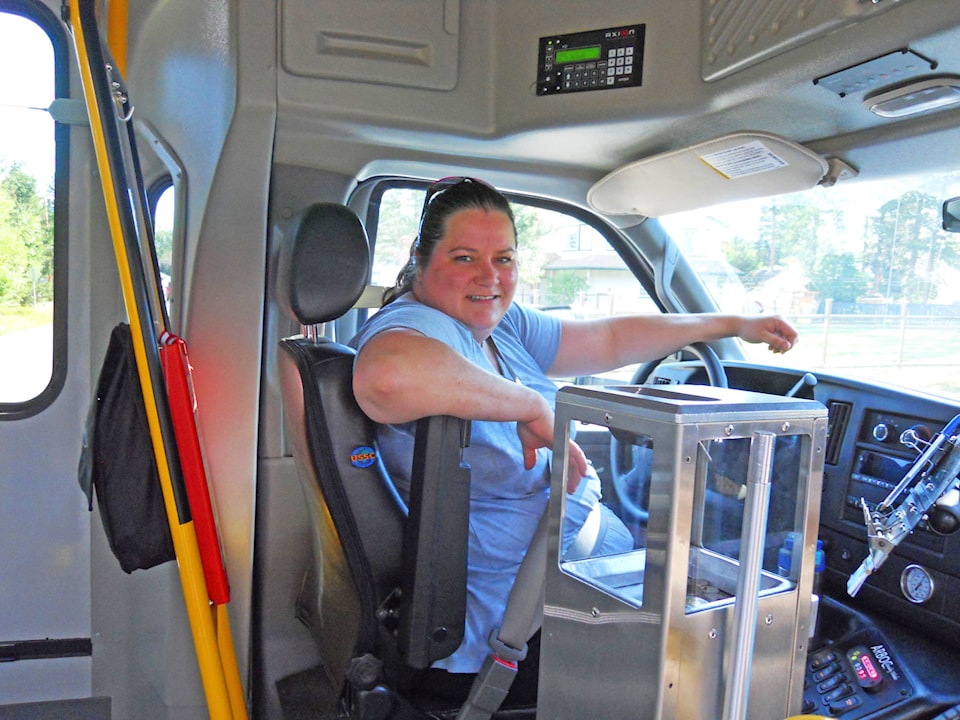If you live in Telkwa, Witset, or so much as along the highway on the outskirts of Smithers you may have used it, or at least seen it: The Smithers bus.
It is a local institution, yet relatively young. Mike Wyllie started the Smithers & District Transit Service (SDTS) in 1991 after writing a successful proposal to the Smithers Community Services Association on the need for a HandyDart transportation service to assist the elderly and disabled in the community. It all started with one man in a van, with Wyllie driving people around town, his service allowing people with mobility issues more independence while living in more remote areas.
“A good point about our service for seniors: In the wintertime and other times a year, we are a safe mode of transportation for them to get their groceries and all that sort of stuff,” says Joanne Lee, the manager of the SDTS.
When Wyllie retired in 2018, it was Joanne Lee who stepped up to the plate. Like Wyllie, Lee does not lead from behind a desk but from behind the wheel, still serving the community as a driver for the service while fulfilling her managerial duties. I sat down with Lee to learn more about the relevance of this public-service to life in the Bulkley Valley.
“I think a lot of people when they think of transit, when it’s in a small town, they assume they will have the same services as a big community. So, they would like us to have transit more often into certain areas or later hours that are maybe a little unrealistic for a small transit system,” Lee says. “People want multiple transits multiple times of day well into the night. It makes sense in a big city where they have the ridership, they have the funding. But in a small town where we have a limited amount of money and we can only deliver what we have delivered already.”
“The BC Transit system basically breaks down areas and has different types of systems that are most effective, are most cost-effective, and basically work for the community’s needs and that’s how they decide what community needs what,” Lee tells me. “Most systems are big enough where they can have a really great conventional system where most people can get to where they need with ‘fixed-route,’ but then there are people in wheelchairs, have decreased mobility, that require to be picked up at their home, to be taken to appointments. And that’s why they split most of those communities up with the conventional and the HandyDart.”
Smithers & District is one of the six communities in B.C. that use what is called a paratransit system of public transportation.The paratransit system is the product of blending aspects of a conventional, fixed-route public transit system with aspects of a demand-responsive transport service (such as HandyDart). This is what Lee refers to as “curb-to-curb”: a system where the passenger may request being picked up from and/or dropped off at locations other than designated bus stops.
“Most people assume it’s only for seniors or only people with physical or mental challenges and that’s not true, anybody can access curb-to-curb.”
Lee says that the para-transit system is used because a conventional route system (like you would see in a more populated city like Prince George) does not fit the needs of the community.
“For the Bulkley Valley, it’s a smaller area. We’re very lucky to have the system we have, I think. It’s not just conventional. It’s not just curb-to-curb. It really helps a lot of people, all three communities: Smithers, Telkwa, Wet’suwet’en [Witset] in their own unique way.”
Since Wyllie started the service in ‘91 the service grew, adopted paratransit, obtained three more drivers and vehicles, and extended routes. But one of the most significant changes to the SDTS occurred in January of 2016: the B.C. Missing Women Commission of Inquiry recommended in 2014 an implementation of safe public transit between Prince Rupert and Prince George, and the SDTS became the first public transit system in the province to implement the B.C. Ministry of Transportation’s “Highway of Tears” strategy by implementing a route between Smithers and Witset in an attempt to reduce the number of people hitchhiking along Highway 16.
Joanne Lee, a former paramedic before becoming involved in the SDTS, believes that public transportation plays a significant role in public safety.
“All buses are considered safe places. So we do have training in first-aid, we are able to contact the RCMP, we are able to contact the ambulance or fire department or any other emergency services that are needed. Yes, the bus is always a safe place so if somebody is in a situation they can come on to the bus and we will take them to a safe area and assist them,” she explains.
“Having a transit bus go to the communities six days a week is a huge improvement to what it was … 30 years ago when there was no option but to hitchhike if you had to. Now there are options for people to have a safe ride to their destination.”

